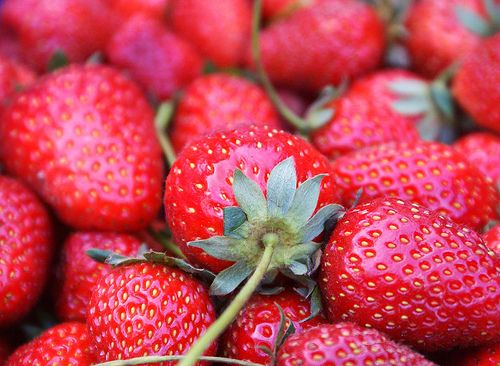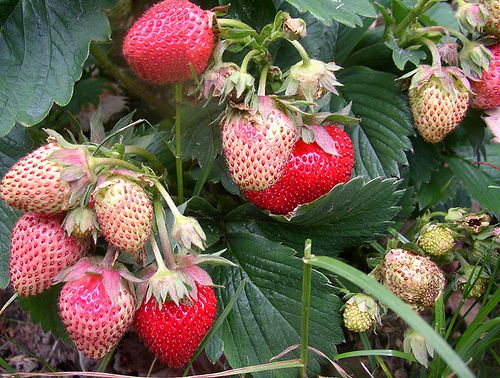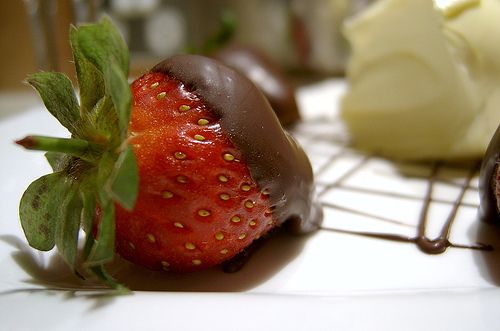
After years of attempting to force my palate to conform to the masses, I finally gave up trying to understand why no one else was talking about the little seeds that became embedded in my molars. I realized that maybe the world was silently cringing just like me to get to the sweet nectar of the strawberry.
Even if you can’t get past the feeling of those seeds, we all know that the fresh goodness of strawberries is well worth a little trouble. Not only is the sugar-berry flavor of strawberries a delicious reward, but they’re also a pretty easy crop to grow in your garden and become even easier the following year.
Strawberries adore basking in the full sun in a well-drained, sandy-loam soil. If you live in a very windy area, they also enjoy an area here they’ll be somewhat protected. They like a soil pH of about 6.0 – 6.5, if you’re into that sort of thing. I’m not, but some people like to know.
You can plant strawberries in their permanent spot as soon as the soil becomes warm enough in your zone to do so. For West Coast gardeners, this can be as early as late winter. I’ve also heard that zones 10-13 have some difficulty with them. But I wouldn’t take that as gospel. I never take zone maps as gospel – I’m rebellious that way.
Before I plant my strawberries, I simply (no serious ritual here) hand-till in 3-4” of compost into the bed or container. As far as watering strawberries, they don’t like to dry out, but wet feet will cause them to get crown rot – so basically water in moderation.
Types of Strawberries
- Junebearers – This type of strawberry plant doesn’t fruit until one year after they’re planted.
- Everbearers – These plants will produce a nice crop of berries late in the summer after planting.
- Day neutrals – These perform basically the same as the everbearers but can produce berries from mid-summer to fall in the same year.
Planting Strawberry Plants
I think this is the only part that you really want to get right. When you plant your little strawberry plants, you’ll want to dig a hole and make a little mound in the middle. Then gently spread out the roots and set it on the mound – think straddling a horse. When you fill the hole in you’re looking to make sure the soil line is at the middle of the crown. If you plant them too deep, you set them up for crown rot, too shallow and the roots become exposed and the plant dies.
Personally, I don’t know if I’m strawberry pot challenged or what, but I have zero luck with growing strawberries in those things. I never seem to get them to take up enough water, plus there’s not a lot of growing room for the roots since ideally, they need about 4” all around for them to feel comfy.
I have better luck with growing them in hanging baskets (put them by the door where you can grab one as you walk by) and have great results with them lining my herb garden beds. Strawberry plants are shallow-rooted so keeping the bed fairly weed-free is important. Aggressive perennial weeds find that it’s a cake walk to overwhelm strawberry beds.
A little annoyance that sometimes creeps up on you (and the strawberries) is a fungus called botrytis. It creates a horrid-looking coat so furry that it could send up a flag for any nearby animal-rights activists. The fungal spores generally come from the old leaves that are on the soil. Botrytis can also grow in organic soil and when you water it hits the soil and splashes back up onto the strawberry blossoms. If you put down 1-2” of composted mulch, it’ll keep the spores from reaching the plant.
Don’t pull on the berry to harvest it from the plant. Instead pinch it off at the stem so you don’t ruin the fruit. Remember to try to harvest all of the ripe or over-ripe berries; this will help reduce problems with disease. I told my strawberry-loving husband that I would put his recipe for eating strawberries in this article, so here it is.
My husband’s favorite way to prepare strawberries:
Wash the strawberries and take the stem off. Cut the berries into quarter pieces. Sprinkle them with a fine baker’s sugar and put them in a covered bowl in the fridge. After a few hours, the juices and sugar make sticky, mouth-watering syrup. I don’t have any idea how long they last as the strawberries are usually gone by the evening.
Fine Gardening Recommended Products

Razor-Back Potato/Refuse Hook
Fine Gardening receives a commission for items purchased through links on this site, including Amazon Associates and other affiliate advertising programs.

A.M. Leonard Deluxe Soil Knife & Leather Sheath Combo
Fine Gardening receives a commission for items purchased through links on this site, including Amazon Associates and other affiliate advertising programs.

Corona High Performance Orchard Loppers
Fine Gardening receives a commission for items purchased through links on this site, including Amazon Associates and other affiliate advertising programs.





















Comments
Log in or create an account to post a comment.
Sign up Log in